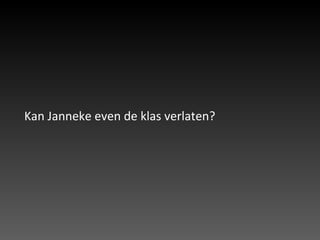UXD Multimedia output
- 1. Kan Janneke even de klas verlaten?
- 2. Kunnen deze twee even naar buiten?
- 3. Attentie
- 5. Real life multimodal use Sequential: Exclusive -Sequential use of modalities that are not linked together in the same task. For example, recording speech and then closing all the unnecessary windows with a mouse. Sequential: Alternate The use of modalities is sequential, but they are linked together in the same task. For example, pointing an object with a mouse and giving a voice command to copy it. Parallel: Concurrent The use of modalities is parallel, but they are not linked together. Usually the hardest kind of multimodal systems, but may result in a better efficiency with some training. For example, driving a car while speaking in a mobile phone Parallel: Synergistic The use of modalities is parallel and they are linked together. For example, pointing and speech command at the same time. [Nigay and Coutaz] Ėý
- 6. Multimodal versus Multimedia Multimodal systems use more than one sense/mode of interaction e.g. visual and aural senses: a text processor may speak the words as well as printing them to the screen Multimedia systems use a number of different media to communicate information e.g. an e-learning system may use video, animation, text and still images and use speech and non-speech Interaction with these systems The combination of human output channels effectively increases the bandwidth of the human-machine channel (e.g., Oviatt, 1999)
- 7. â Bandwithâ in computer game history Examples text based adventures adding graphics print Sound and space 3 d space 3d audio haptic
- 8. Multimodal output -Visual: Text, pictures, signs, color -Audio: Verbal, non-verbal, signals -Olfactory: Smell -Haptic (combination of movement and tactile)
- 9. Signs
- 10. Signs (sound)
- 11. Smell
- 12. Ėý
- 13. Haptic Haptic torch
- 14. Synchronisation and space example
- 15. Multimodal interaction and multisenory feedback can exert significant cognitive demands on users. Attention is selective and has limited capacity. Short term memory also has limitations. Consider human ability when designing the interface, essential for control and learning affordancesĖý Classic example Convention communication Confusion...
- 16. Questions?... Any? Who dares?




![Real life multimodal use Sequential: Exclusive -Sequential use of modalities that are not linked together in the same task. For example, recording speech and then closing all the unnecessary windows with a mouse. Sequential: Alternate The use of modalities is sequential, but they are linked together in the same task. For example, pointing an object with a mouse and giving a voice command to copy it. Parallel: Concurrent The use of modalities is parallel, but they are not linked together. Usually the hardest kind of multimodal systems, but may result in a better efficiency with some training. For example, driving a car while speaking in a mobile phone Parallel: Synergistic The use of modalities is parallel and they are linked together. For example, pointing and speech command at the same time. [Nigay and Coutaz] Ėý](https://image.slidesharecdn.com/rolf-maandagmaart2009-090402115223-phpapp01/85/UXD-Multimedia-output-5-320.jpg)










